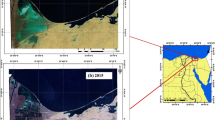Ecosystems in semi-arid regions appear to be undergoing degradation processes commonly described as desertification. Desertification has been widely recognized as one of the most serious environmental problems in world, although its concept and causes are still debated in scientific communities. The semi-arid region in North Africa is ideal for investigating the processes and mechanisms of desertification due to its very sensitive ecosystem. The desertification constitutes one of the major concerns of the countries of the Sahel and North Africa. This phenomenon is responsible for the degradation of natural habitat and for arable land disappearance. Using the Sandy land of Choott El-Garssa, a former dormant dunes and wetlands environment, we monitored the variation of the desertified land and the wetlands in order to assess the climatic and human impacts on the processes of desertification. The research methods included digital image processing of high resolution of satellite data and field verification. Remote sensing data shows that the wetlands were larger in Oudia area. The variation of the extension of mobile dunes is in inverse proportion to that of wetlands. The main process of desertification is the reactivation of dormant sand dunes. The changes of wetlands and desertified lands correlate considerably well with the variations of local precipitation and temperature, suggesting that climate might be the key factor triggering desertification in the Oudia area. In other sandy lands of Oudia area, however, human activities might be the key factor causing desertification and land degradation. With the development of remote sensing techniques, it became possible to study this phenomenon through several scales and to analyze the interaction between the various elements of the environment in relation with the dynamics of soil and the human activity. This study was an attempt to use high-resolution satellite data Quick Bird for mapping desertification in the zone of Tozeur. The example selected for this paper is the sector of Oudia located about 12 km North West of Tozeur. The methodology used is the simultaneous approach of geomorphological and digital analysis of high-resolution satellite data for defining and mapping the desertification landscape. Visual interpretation combined with supervised classification using training site tests allowed us to perform a precise identification and led us to an accurate mapping desertification sensibility. As a result, it appears that Oudia is threatened by the encroachment of sand dunes and a significant wind activity. In conclusion, the study strongly recommends the use of these new techniques of remote sensing in desertification assessment and mapping.
Access this chapter
Tax calculation will be finalised at checkout
Purchases are for personal use only
Preview
Unable to display preview. Download preview PDF.
Similar content being viewed by others
Bibliography
Blaikie P. and Brookfield H. 1987. Land degradation and society, Longman, London
Clarke and Noin 1998. In: J. Clarke and D. Noin, Editors, Population and environment in arid regions, UNESCO/Partenon Publishing Group, Paris, pp. 1–18
Global Land Cover Facility: ftp://ftp.glcf.umiacs.umd.edu/glcf/Mosaic_Landsat/N-32/ N-32-30.ETM-EarthSat-MrSID/
Laboratorio TELEGIS, Dipartimento Scienze della Terra, Università di Cagliari - http:// www.unica.it/telegis/
Murray S., Burke L., Tunstall D., and Gilruth, P. 1999. Drylands population assessment II. UNSO
Strahler A. and Strahler A. 1992. Modern physical geography, Wiley, New York
Talbi M., Gasmi N., and Marini A. 2006. Présentation générale de la région de Tozeur (Le Jerid), Cartographie des paysages arides pour la lutte contre la désertification, Tozeur,Tunisie. 9–19 décembre 2006, p. 28
UNCCD. 2004a. FAQ. http://www.unccd.int/knowledge/faq.php#answer2
UNCCD. 2004b. FAQ. http://www.populationdata.net/images/cartes/tunisie.jpg
United Nations. 1994. Elaboration of an international convention to combat desertification in countries experiencing serious drought and/or desertification, particularly in Africa.Final text of the Convention. www.unccd.int/convention/text/pdf/conv-eng.pdf
Author information
Authors and Affiliations
Editor information
Editors and Affiliations
Rights and permissions
Copyright information
© 2009 Springer Science + Business Media B.V
About this paper
Cite this paper
Arnous, M.O. et al. (2009). Remote Sensing Technology Applications For Desertification Mapping: A Case Study, Oudia Area, Tunisia. In: Marini, A., Talbi, M. (eds) Desertification and Risk Analysis Using High and Medium Resolution Satellite Data. NATO Science for Peace and Security Series C: Environmental Security. Springer, Dordrecht. https://doi.org/10.1007/978-1-4020-8937-4_16
Download citation
DOI: https://doi.org/10.1007/978-1-4020-8937-4_16
Publisher Name: Springer, Dordrecht
Print ISBN: 978-1-4020-8936-7
Online ISBN: 978-1-4020-8937-4
eBook Packages: Earth and Environmental ScienceEarth and Environmental Science (R0)




